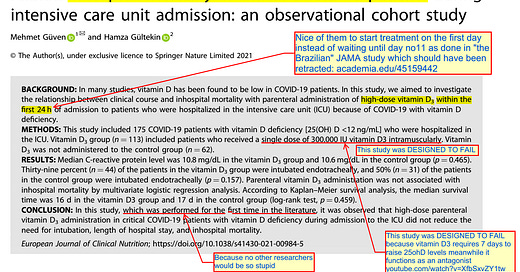Research Designed to Fail: Effect of high-dose parenteral vitamin D3 on COVID-19-related inhospital mortality during intensive care unit admission. Eur J Clin Nutr 2021 July
Either these researchers are ignorant about vitamin D pharmacology or they intentionally designed this study to produce negative results
Executive summary by Dr Vasquez:
Authors Güven and Gültekin published "The effect of high-dose parenteral vitamin D3 on COVID-19-related inhospital mortality in critical COVID-19 patients during intensive care unit admission" in European Journal of Clinical Nutrition 2021 July wherein they administered a single massive bolus dose of vitamin D3 300,000 IU intramuscularly on the first day of hospital admission of critically ill Cv19 patients; this study was doomed to failure from its inception, per either the ignorance or maleficence of the authors because the 300,000 IU massive bolus dosing used in this study was inappropriate and potetially harmful:
Bolus (>100,000 IU) vitamin D3 is not immediately effective and is therefore inappropriate for an acute illness, and this is well-known: This clinical trial gives the illusion of immediate intervention while the treatment with nonphysiologic megabolus vitamin D3 requires 7 days to raise 25-oh-D; this is common knowledge per previous basic science data on the pharmacology of vitamin D; this demonstrates a failure of the authors to review the relevant literature for appropriate administration of the therapeutic agent they were using; they should have used semiactivated 25-oh-D which has already proven effective in the same clinical setting; either hypocritically or ironically, these authors cite the 2017 metaanalysis (Martineau BMJ 2017 10.1136/bmj.i6583) which clearly stated “Treatment with large boluses of vitamin D has been associated with reduced efficacy for non-classic effects and in some cases an increased risk of adverse outcomes.” and “…bolus dose vitamin D supplementation did not offer any protection against acute respiratory tract infection even when administered to those with circulating 25-hydroxyvitamin D concentrations less than 25 nmol/L.” What is the point in proceeding with a study design with an intervention already shown to be ineffective and potentially harmful? Why did the authors perform this type of research and why did the journal publish it?
Bolus (>100,000 IU) vitamin D3 functions in an antagonistic manner by flooding the blood/tissues with the weak agonist which appears to impair function of 25-hydroxy-vitamin D (the major biologic agonist) and 1,25-hydroxy-vitamin D (the major pharmacologic agonist),
Bolus (>100,000 IU) vitamin D3 induces vitamin D-neutralizing pathways to promote clearance of vitamin D from the body: This has been published by Vieth, including within the 2017 BMJ metaanalysis, “Vieth [Anticancer Res 2009 Sep] has proposed that high circulating concentrations after bolus dosing may chronically dysregulate activity of enzymes responsible for synthesis and degradation of the active vitamin D metabolite 1,25-dihydroxyvitamin D, resulting in decreased concentrations of this metabolite in extra-renal tissues. Such an effect could attenuate the ability of 25-hydroxyvitamin D to support protective immune responses to respiratory pathogens.”
The authors erroneously claim to be first to perform a study such as this, whereas 1) many other authors have performed better studies using vitamin D against viral infections including Cv19, and 2) they are clearly not the first to use intramuscular bolus dosing of D3, as was already performed and publshed in J Crit Care 2018 Apr: 46 adult patients suffering from VAP and vitamin D deficiency were enrolled. The first group of patients received single intramuscular injection of vitamin D (300000 IU)…”
Because of the futile therapeutic intervention, this study had nearly zero opportunity for clinical success and should be annotated as such and/or withdrawn from publication to avoid confusion and contamination of the research literature and clinical/political decision-making.
See also: Vasquez A. Vitamin D Bolus Reconsidered: Physiologic Dosing versus Pandemic Consequences of Codified Confusion. IJHNFM 2021 Feb
Dr Alex Kennerly Vasquez (introduction; brief Bio-CV) writes and teaches for an international audience on various topics ranging from leadership to nutrition to functional inflammology. Major books include Inflammation Mastery, 4th Edition (full-color printing, 1182 pages, equivalent to 25 typical books [averaging 60,000 words each]), which was also published in two separate volumes as Textbook of Clinical Nutrition and Functional Medicine (Volume 1: Chapters 1-4; Volume 2: Chapter 5—Clinical Protocols for Diabetes, Hypertension, Migraine, Fibromyalgia, Rheumatoid Arthritis, Psoriasis, Vasculitis, Dermatomyositis and most other major inflammatory/autoimmune disorders); several sections have been excerpted including Antiviral Strategies and Immune Nutrition (ISBN 1502894890) (aka, Antiviral Nutrition [available as PDF download] and Brain Inflammation in Chronic Pain, Migraine, and Fibromyalgia. Dr Vasquez’s books are available internationally via bookstores such as BookDepository, Amazon.com, Barnes and Noble, ThriftBooks, AbeBooks, BetterWorldBooks, WaterStonesBooks and his new Telegram channel is https://t.me/DrAlexVasquez.
This wonderful and insightful conversation is not personalized medical advice :-)





